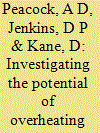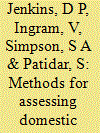| Srl | Item |
| 1 |
ID:
113487


|
|
|
|
|
| Publication |
2012.
|
| Summary/Abstract |
A changing climate will produce summertime overheating where conventional domestic building design approaches do not adequately address future warming risk. This risk cannot be fully identified and avoided unless future climate information and building related adaptation measures are considered. The Low Carbon Futures project is developing a tool that uses UKCP09 climate projections input to predict dwelling overheating risks. To enhance the usefulness of this tool for the building industry, and to better understand current building design processes, interviews were conducted with building professionals, allowing industry preferences for the tool to be sought and to provide clearer indications of proposed outcomes. This paper examines results from a questionnaire, focus groups and semi-structured interviews with building industry professionals. The research shows that the housing industry maintains adherence to traditional designing methods where overheating, whether current or future, is not considered a serious concern. No design stage detailed overheating assessments are currently undertaken to reduce the UK's increased room air-conditioner sales, despite drives for low energy/zero carbon homes. The collated feedback will help tailor the tool and its eventual outputs, with this paper attempting to converge on a set of recommendations for low carbon dwelling design with reduced overheating risk.
|
|
|
|
|
|
|
|
|
|
|
|
|
|
|
|
| 2 |
ID:
105226


|
|
|
|
|
| Publication |
2011.
|
| Summary/Abstract |
Economic overheating is a significant and recurring problem in modern China. This paper analyzes the many factors causing overheating and argues that there are systemic and largely structural explanations for overheating that arise from a number of theorized catalysts, including a bureaucratic catalyst and a historical catalyst.
|
|
|
|
|
|
|
|
|
|
|
|
|
|
|
|
| 3 |
ID:
096634


|
|
|
|
|
| Publication |
2010.
|
| Summary/Abstract |
Dynamic simulation is used with defined domestic building variants to investigate internal temperatures of UK dwellings. Factors such as a warming climate and varying internal heat gains are estimated to examine whether UK domestic buildings are likely to be prone to overheating in the future, and therefore require mechanical air conditioning. The study suggests that the ability, or inability, of the occupant to adapt to bedroom temperature is paramount in the understanding of the conditions for overheating. While this is difficult to quantify (and a range of comfort temperatures are proposed), the effect of changing the building construction and geographical location can result in significantly different thermal conditions. As might be expected, the problem appears most noticeable for buildings in the south of the UK and with lightweight constructions. Even with a window-opening schedule applied to such a scenario, the average internal temperature is simulated as being over 28 °C for almost 12% of the year. A different metric, defined as "cooling nights", suggests that there might be a cooling problem in bedroom areas for approximately a third of the year. In the North of the UK, and also for solid wall dwellings, this problem diminishes significantly.
|
|
|
|
|
|
|
|
|
|
|
|
|
|
|
|
| 4 |
ID:
121326


|
|
|
|
|
| Publication |
2013.
|
| Summary/Abstract |
Due to both changing building design and projected climate change, the conditions within dwellings in the UK are likely to show increased risk to overheating. There is therefore a growing requirement for a suitable industry standard to assess overheating risk in the domestic sector, ensuring that both new dwellings and refurbishments to existing dwellings take future climate into account. This study compares the type of advice gained and the form of calculation used for a series of different summertime overheating analyses. Using simple overheating definitions, a case-study dwelling is simulated for two UK locations across different climate scenarios and the consistency in advice provided by the chosen methods is discussed. The results suggest there are issues around the consistency of such varied models, but also highlight the need to strike a balance between a method that reliably accounts for building thermal performance while also providing a clear and useable approach that can be adopted within industry practice.
|
|
|
|
|
|
|
|
|
|
|
|
|
|
|
|